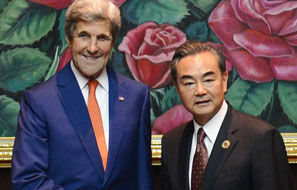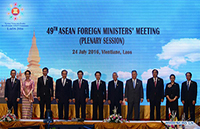Otherwise, it will create a negative perception of judiciary's independence, says CJ
https://youtu.be/rKJy0vpNVlA
KUALA LUMPUR: The Attorney-General must stop leading the Judicial and Legal Service Commission to ensure that the judiciary can be seen as a truly independent body, says the Chief Justice.
The head of the judiciary, Tun Arifin Zakaria, said that it would be a conflict of interest for the A-G to lead both services as he was a member of the Executive, when judicial officers comes under the judiciary.
In a democracy, the three branches of Government – the Legislative, Executive and Judiciary – must remain independent of each other.
“If the A-G continues to lead both services, I worry it would create a negative perception of the judiciary’s independence, an opinion many parties share,” said Arifin in a speech at the Judicial Officers Conference here yesterday.
The Chief Justice’s call is in line with the universal concept of judicial independence, whereby the courts should not be subject to undue influence from other branches of the Government or persons with partisan interests.
In an immediate reaction, Attorney-General Tan Sri Mohd Apandi Ali confirmed that the A-G’s Chambers (AGC) had received the proposal and was still studying it from the point of view of the Constitution and from a historic perspective.
“We will come up with the AGC’s views and discuss it at our next Legal and Judicial Service Commission’s meeting before the end of the year,” he told The Star.
Currently, the Judicial and Legal Service Commission managed the careers – from appointing, promoting, transferring and disciplining – of its members, which includes judicial officers like Sessions Court judges and magistrates, and legal officers like deputy public prosecutors and senior federal counsels.
Later, during a press conference, Arifin said people who disagreed with a judgment might say the magistrates were toeing the line with the A-G’s Chambers as they were effectively the same body.
“Imagine if a senior officer from the AGC or even the A-G himself was prosecuting. Lagi menggeletar (they’ll be even more nervous) to handle the case,” he said.
Arifin said Public Service Circular 6/2010 which made the A-G the chief of the judicial service was a contradiction to an existing decision by the Federal Court and no longer relevant
He pointed out that when the Commission was formed, the two groups were placed together as there were only a few hundred staff members. However, there were now 636 employees in the legal service and 4,787 serving in the judicial service as of April this year.
“The time has come for the judicial service to be lead by an someone from within its ranks,” he said, adding that such a candidate would be better equipped to run the service.
Arifin suggested that the Chief Court Registrar lead the judicial service while the Attorney-General lead the legal service.
The separation would also stop judicial officers and legal officers from being transferred between departments, unless the move is approved in writing by their chiefs.
However, Arifin said transfers should still be allowed, with due process, to ensure staff get experience as both judges and prosecutors.
Chief Registrar Datin Latifah Mohd Tahar, who also attended the conference, told reporters the paper on the proposal had been submitted to the Commission and the matter could be decided on within the year.
In 2006, the then Chief Justice Tun Ahmad Fairuz Sheikh Abdul Halim said the Judiciary intended to propose to the Government to abolish the Judicial and Legal Service Commission.
He added that magistrates and Sessions Court judges should be absorbed into the judiciary, fearing that there would be interference by “unseen hands” if they remain as civil servants.
by Chelsea L.Y. Ng and Qishin Tariq The Star/Asia News Network
It’s about time, says thelegal fraternity of proposal
PETALING JAYA: The legal fraternity applauded the Chief Justice’s proposal for greater separation between judicial and legal services, calling it long overdue.
Former Court of Appeals Justice Mah Weng Kwai (pic) said the proposal finally presented a clear demarcation between the judicial and legal services.
“It has been a combined service for the longest time, since before I joined the service in 1973,” said Mah, who started his career as a magistrate before becoming a deputy public prosecutor and then senior federal counsel.
Responding to the Chief Justice’s suggestion that officers would still be allowed to be transferred between the services, Mah said it should be taken one step further with both services completely independent and non-transferable.
Former magistrate Akbardin Abdul Kader said, if implemented, the move would ensure former DPPs were not biased when they were elevated to the bench.
“Hence, they will remain as DPPs until they retire and so the same for judicial officers,” he said.
Malaysian Bar president Steven Thiru said the Chief Justice’s concerns were valid and deserved due consideration.
He said the fact the Attorney-General was a member of the commission could open the judiciary to questions in any decision in favour of the prosecution.
He noted that the proposal would appear to require a constitutional amendment that would place Sessions Court judges and magistrates under the sole jurisdiction of the judiciary, and no longer under the Commission.
“This strengthens the concept of separation of powers that vests judicial power in the judiciary and requires the exercise of those powers without any influence by the other arms of Government,” he said, adding that the removal of any conflict of interest would inspire more confidence in the decisions of Sessions Court judges and magistrates.
Former Malaysian Bar president Yeo Yang Poh said the Bar had called for the change for decades, adding that from time to time, a Chief Justice of the day would “warm up” to the idea.
In 2006, when Yeo was serving as president, Chief Justice Tun Ahmad Fairuz Sheikh Abdul Halim made a similar call for a separation of the judiciary from the commission.
Yeo added that it was the first time he had heard of a proposal being handed to the commission by the Chief Registrar.
He said having the judicial and legal services combined was not desirable for two reasons: in practical terms, not every one could be fearless; while in theory, even if all legal officers could overcome the pressure, there would still be the perception of impartiality.
“You can’t blame an observer that perceives something is not quite right. A judge could say they would remain impartial even if judging their father; but does it look right?” he asked.
A former officer from the Judicial And Legal Services, who declined to be named, said the risk of transfers were a common reality.
“We used to threaten judges up to the Sessions Court (level), if they misbehave, we will get them transferred as DPPs. A few of them were actually transferred,” he said.
He said though the “threats” were in jest, it shocked him that they were sometimes really carried out, adding that not all moves were sinister, as it was occasionally meant as a lesson for subordinate courts which had made errant judgments.
Jan 22, 2014 ... Stupid fellow ! Dr Ling, former Malaysian Transport Minister slams Attorney-
General. UTAR Council Chairman Tun Dr Ling Liong Sik speaking ...
Jul 7, 2015 ... Separate the Attorney-General's powers to correct a flaw in Malaysian legal
system ! ... There is a flaw in our system, inherited since before Independence,
that may ... Najib has denied any wrongdoing and he is said to be mulling legal
.... Dr Ling, former Malaysian Transport Minister slams Attorney-General.

Apr 8, 2016 ... “1MDB relied on debt (bank loans, bonds and sukuk) to form its capital, a chunk
of which had been sanctioned or supported by the Government ...
Jun 4, 2015 ... Malaysia's 1MDB's questionable accounts. Summary raises questions over
spending. It shows where money went but fails to debunk critics.































